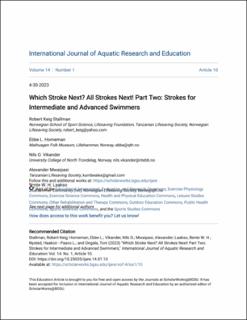"Which stroke next? All strokes next!": Part two: Strokes for intermediate and advanced swimmers
| dc.contributor.author | Stallman, Robert Keig | |
| dc.contributor.author | Horneman, Ebbe L. | |
| dc.contributor.author | Vikander, Nils Olof | |
| dc.contributor.author | Mwaipasi, Alexander | |
| dc.contributor.author | Laakso, Bente W. H. | |
| dc.contributor.author | Nysted, Haakon-Paavo L. | |
| dc.contributor.author | Ongala, Toni | |
| dc.date.accessioned | 2024-03-18T16:41:29Z | |
| dc.date.available | 2024-03-18T16:41:29Z | |
| dc.date.created | 2023-08-18T09:00:40Z | |
| dc.date.issued | 2023 | |
| dc.identifier.citation | International Journal of Aquatic Research and Education. 2023, 14(1), Artikkel 10. | en_US |
| dc.identifier.issn | 1932-9997 | |
| dc.identifier.uri | https://hdl.handle.net/11250/3122965 | |
| dc.description.abstract | The primary goal of this two-part project is to answer the rhetorical question of which strokes should be taught first, and which later (Langendorfer, 2013, Stallman, 2014a). As you have seen in Part One, we emphasize (as have many others) the need for a firm foundation before any stroke is introduced. When the learner is ready for propulsive motor competencies, there is no stroke which suits all as their first. In Part One we explored the “beginning strokes” all of which are candidates for any given learner’s first stroke. We also argued that after mastering their very first stroke the learner should learn the other, “first strokes.” This also broadens the base for the learning of other strokes as the learner advances to intermediate and advanced levels. Here in Part Two, we explore additional strokes, chosen as essential because of some unique quality which makes them the best solution in some specific, potential risk situation. They should, therefore, be included in any comprehensive, proactive aquatic educational program. | en_US |
| dc.language.iso | eng | en_US |
| dc.subject | back crawl | en_US |
| dc.subject | breaststroke | en_US |
| dc.subject | essential strokes | en_US |
| dc.subject | front crawl | en_US |
| dc.subject | human stroke | en_US |
| dc.subject | overarm sidestroke | en_US |
| dc.subject | sidestroke | en_US |
| dc.subject | swimming | en_US |
| dc.subject | swimming strokes | en_US |
| dc.subject | water competence | en_US |
| dc.title | "Which stroke next? All strokes next!": Part two: Strokes for intermediate and advanced swimmers | en_US |
| dc.type | Peer reviewed | en_US |
| dc.type | Journal article | en_US |
| dc.description.version | publishedVersion | en_US |
| dc.rights.holder | © 2023 The Author(s) | en_US |
| dc.source.pagenumber | 20 | en_US |
| dc.source.volume | 14 | en_US |
| dc.source.journal | International Journal of Aquatic Research and Education | en_US |
| dc.source.issue | 1 | en_US |
| dc.identifier.doi | 10.25035/ijare.14.01.10 | |
| dc.identifier.cristin | 2167831 | |
| dc.description.localcode | Institutt for fysisk prestasjonsevne / Department of Physical Performance | en_US |
| dc.source.articlenumber | 10 | en_US |
| cristin.ispublished | true | |
| cristin.fulltext | original | |
| cristin.qualitycode | 1 |
Tilhørende fil(er)
Denne innførselen finnes i følgende samling(er)
-
Artikler / Articles [2119]
-
Publikasjoner fra Cristin [1107]
